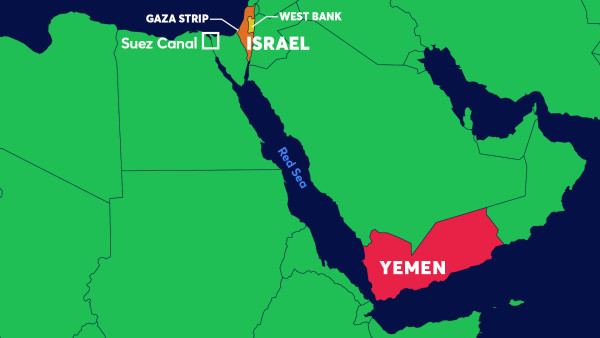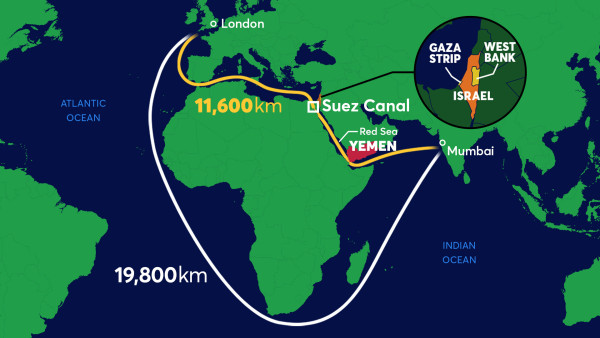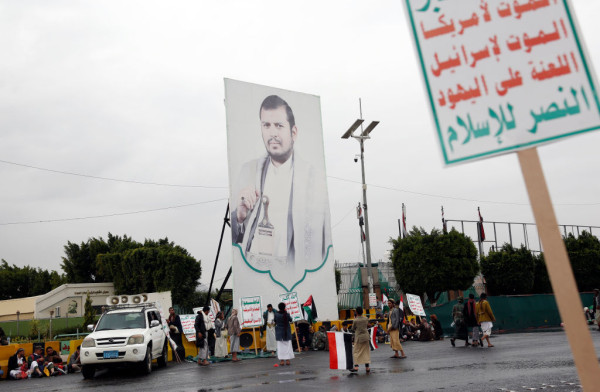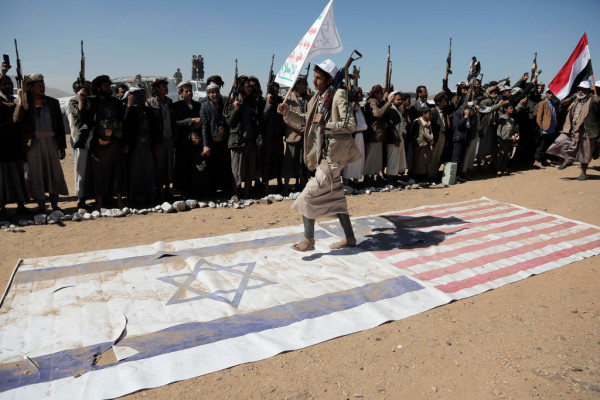As well as causing death, destruction and devastation in Gaza, Israel’s military campaign in response to the October 7 Hamas attack is also causing waves on the Red Sea.
The Houthis are an armed group in Yemen, once described as “mere upstarts in flip-flops'', but they have managed to completely upend one of the world’s busiest trade routes by firing missiles and hijacking ships in the crucial Red Sea passage.
The US and UK have launched air strikes against Houthi targets in response and now New Zealand is also joining in by sending six NZ Defence Force personnel to help.
So why are the Houthis attacking ships in the Red Sea?
The Houthis claim they are carrying out these attacks - which have so far not killed anyone - in protest against Israel’s military assault on Gaza and the US support for it.
They began attacking ships on the Red Sea on October 19 and claim they’re only going after ships that are Israeli-owned, flagged or operated or are heading to Israeli ports.
But some of the vessels that have been targeted say they’ve got no link to Israel and the US says two of its flagged ships have also come under attack.
There have been dozens of vessels targeted but the most high profile Houthi hijacking involved the Galaxy Leader cargo ship where armed men in balaclavas dropped out of a helicopter before moving onto the ship’s bridge, forcing the civilian crew to lie down at gunpoint and cutting all communication.
The Houthis say they’ll only stop their attacks if Israel’s “crimes in Gaza stop and food and medicines and fuel are allowed to reach its besieged population,” according to senior Houthi official Mohammed al-Bukhaiti.
Where is the Red Sea and why is it important?
The best way to understand the Red Sea’s importance is to look at a map: the Red Sea runs between Africa and the Middle East, with Yemen at one end and Egypt and Israel at the other.
The Red Sea runs between Africa and the Middle East, with Yemen at one end, and Egypt and Israel at the other.

The entry point, between Yemen and Djibouti, is only 26 kms across at the narrowest point. Image: Re: News
It is a crucial and narrow passage for ships that allows them to travel from Asian ports and then connects to the Suez canal and onto Europe.
The entry point, between Yemen on the Middle East side, and Djibouti on the Africa side, is very narrow - only 26 kms across at the narrowest point.
This means it’s a chokepoint for ships trying to get into the Red Sea, and the Houthis in Yemen have been able to act almost as gatekeepers to ships.
It’s one of the most important shipping routes in the world: According to the US Energy Information Administration, about 8.8 million barrels of oil pass through the route each day.
Houthi attacks led to global trade dropping 1.3% from November to December 2023 as the amount of cargo transported in that region plunged.
To avoid the Red Sea passage, ships are now diverting to go around the very bottom tip of Africa before turning back up to head towards Europe.

The yellow line on this map shows the shipping route through the Red Sea. Houthis based in Yemen have begun attacking ships in protest against Israel’s bombardment of Gaza. The white line shows the longer route some ships are now taking to avoid the Red Sea passage. Image: Re: News
What are other countries doing?
The US and the UK started carrying out strikes against Houthi targets this month and are promising more.
When asked by a reporter if the strikes against the Houthis were working, US President Joe Biden responded: “Well, when you say working, are they stopping the Houthis? No.
Are they going to continue? Yes.”
According to Hussain Al Bukhato, an analyst aligned with the Houthis, the US-led military action will not stop them.
“They [the Houthis] know, you can only hurt the West in their pocket,” he said.
The US and UK have been criticised for taking military intervention in the shipping route, but not taking similar action over the death and destruction in the region.
British journalist Myriam Francois said in an interview with Sky TV: "How dare we have a conversation about trade when there are children right now being treated without anaesthetic."
What is New Zealand doing?
Following a request from the United States, on January 23 the government announced New Zealand would send six Defence Force personnel to help the US and the UK stop the Houthi attacks.
Prime Minister Christopher Luxon said: “Nearly 15 percent of global trade goes through the Red Sea and the Houthi attacks are driving costs higher for New Zealanders and causing delays to shipments”.
Foreign Minister Winston Peters said the decision was about “international security and the free flow of trade on which New Zealanders rely”, rather than New Zealand’s position on the Israel-Gaza conflict.
"It … impacts the cost of living here ... this piracy threatens the hundreds of millions of innocent consumers worldwide," he said.
Labour and the Green Party oppose the deployment, with Labour foreign affairs spokesperson David Parker saying the decision has “shades of Iraq”.
Who are the Houthis?
Houthis are from the minority Zaydi religious group, which is an offshoot or sub-sect of Shia Islam and come from the rugged, mountainous and impoverished Saada region in Yemen’s far north.
For centuries Yemen was ruled by Zaydi Shia imams until 1962 when a revolution overthrew them and established a ruling class of families and the Houthis were left powerless.
The Houthi movement was revived in the 1990s and took its name from new founder Hussein al Houthi but it was less of a religious movement and more focused on economic and political changes.

Yemenis loyal to the Houthi movement are seen next to a large billboard depicting the leader of the Houthi movement Abdul-Malik Badreddin al-Houthi. Photo: Mohammed Hamoud/Getty Images
In 2003, the Houthis called for mass protests against the Yemeni government’s support for the US invasion of Iraq and around that time the Houthis also became associated with the slogan “Death to America, Death to Israel”.

Houthi fighters rally in Sanaa. Photo: Mohammed Hamoud/Getty Images
But one of the group’s main aims was to rally against rampant corruption, especially in the government which was led by long-time leader President Ali Abdullah Saleh.
Saleh ruled Yemen from 1990 to 2012 and was known for his political cunning which he used to control and manipulate a patchwork of local alliances and tribal groups, including the Houthis.
His relationship with the Houthis was both complicated and violent.
During Saleh’s time in power, he fought long-running wars against the Houthis but then also helped bring them to power in 2014 before turning on them again which led to one of their snipers assassinating him in 2017. It was a political gamble that did not pay off.
But to understand how the Houthis rose to political prominence in Yemen, we have to rewind to 2011.
How did the Houthis come to power?
In 2011 the Arab world was gripped by popular uprisings against authoritarian rulers, with some ending in revolution like Tunisia and Egypt and others in prolonged civil wars like Libya and Syria.
At the time, protests were growing in Yemen too which were endorsed by the Houthis and started to swell into the hundreds of thousands.
After months of rallies, in 2012 Saleh agreed to step down and hand power to his Vice President Abd-Rabbu Mansour Hadi before an early election and in return got immunity from prosecution.
Saleh had received safe passage out of Yemen from regional ally Saudi Arabia.
A national dialogue conference was also set up to map out a political future for Yemen to include proper political representation for various groups including the Houthis.
But in 2014, the Houthis and their supporters were infuriated by the Hadi-led government’s decision to increase the price of fuel and its failure to implement recommendations from the 10-month-long national dialogue conference.
The fuel hike was the populist issue the Houthis rallied behind with thousands of people protesting in the streets again, urging the government to step down, and this prompted the Houthis to storm the capital, Sanaa.
They quickly took hold of the Presidential palace, key military infrastructure and formed their own ruling council.
Then president Hadi refused to comply with Houthi demands and fled while former President Saleh re-emerged in Yemen, threw his weight behind the Houthis and forged a fragile and unlikely alliance that angered former ally Saudi Arabia.
Why did Saudi Arabia attack Yemen?
In March 2015, a Saudi-led coalition with support from the United States, began a military campaign to roll back the Houthis and reinstate Hadi to the presidency in Sanaa.
In the weeks before, the Houthis had rejected an invitation by Saudi’s Crown Prince Mohammed Bin Salman - also known as MBS - to come to Riyadh, the capital of Saudi Arabia, for talks.
Farea al-Muslimi is a Yemeni expert at the Chatham House think-tank and wrote in this essay that the move enraged MBS.
“The Houthis’ refusal to attend was a personal affront to MBS, who could not stomach the idea that the Houthis - mere upstarts in flip-flops from the mountains - refused to show up”.
The coalition forces also staged a de facto air, land and sea blockade which stopped the vital supply of food, medicine and drove up the price of basic goods.
Yemen was already one of the poorest countries in the world when the conflict began but the eight year conflict spawned a humanitarian disaster.
The UN Development program estimated more than 370,000 people died as a result of the war, with lack of food, water and health services being responsible for about 60 percent of deaths.
And in 2020 UNICEF described Yemen as “the largest humanitarian crisis in the world” with 17 million people going hungry.
“Around 2.2 million children require treatment for malnutrition, and a staggering 540,000 of them are in a life-threatening state of severe acute malnutrition”, a UNICEF statement said.
The Saudi intervention is widely seen as disastrous.
In 2022, after nearly a decade of war that killed hundreds of thousands of Yemenis, destroyed years of progress and development, the Houthis were still in power and Saudi decided to cease hostilities and start peace talks with them.
What is their link to Iran?
One of the narratives that is relayed consistently about the Houthis, especially from the United States government, is that the Houthis are an Iranian proxy group which means the group is acting on behalf of or for Iran.
Iran has praised Houthis attacks on Red Sea ships but denies US accusations that it has helped the Houthis plan or carry out the attacks.
The Houthis are part of Iran’s Axis of Resistance - which includes the Palestinian group Hamas and Hezbollah from Lebanon - but analysts say those groups tend to act independently.
al-Muslimi says the reality is more complicated and somewhere in the middle.
He says the Houthis’ link to Iran is destructive but also exaggerated.
“Iran’s support to the Houthis in Yemen is very small compared to that of Iraq, Syria or Lebanon. It is not that Iran’s support isn’t a destructive force - it is - but it is not the main or only one,” he wrote.
He says the arrangement between the Houthis and Iran was much looser until the Saudi-led military intervention which pushed the two closer together.
“The weapons and business Houthis get from the black market from the Yemeni government, for example, are worth more than the funding they get from Iran. Even countries like Oman and Russia currently have more direct leverage over the Houthis than Iran does.”
This is backed by Ben Rhodes who was the deputy national security to President Barack Obama.
“They were not a creation of Iran…They are a force in Yemen that has a relationship with Iran that is tied to their sectarian identity as shia”, he told his Save the World podcast.
“But they don’t take all their orders from Iran, everything they’re doing is not an extension of Iranian foreign policy, it is murkier than that.”
So what next?
Al-Muslimi says the Houthis will not back down.
“The Houthis are far more savvy, prepared, and well-equipped than many Western commentators realize.
“They are highly experienced in waging war after years of brutal conflict, involving direct confrontation with Saudi Arabia,” he wrote.
He says for the last five years Houthi capabilities have been consistently underestimated.
“The Houthis know that international support for the US and UK strikes is thin.
“The Saudis, for instance, have stayed out - having seen their own air strikes against the Houthis fail to achieve results for nine years,” he says.
Houthis have been accused of abuses by Human Rights Watch which include the widespread use of arbitrary detention, ill-treatment and torture in facilities they run.
And while many Yemenis have been struggling under their conservative rule, the war on Gaza and the plight of Palestinians is a galvanising force.
“As long as the Gaza war goes on, the Houthis will escalate in the Red Sea,” says al-Muslimi.
Banner image: Houthi fighters lift their rifles at a tribal gathering in Yemen’s capital, Sanaa. (Photo by Mohammed Hamoud/Getty Images)
More stories:
Explainer: South Africa’s genocide case against Israel
An urgent hearing is set to begin at the International Court of Justice. Here’s what it is about.
The world’s focused on Gaza but violence is rising in the West Bank
There’s been a surge of violence in another Palestinian territory the occupied West Bank.
How to make sense of what’s going on in Gaza
The violence over the past two weeks is the result of decades of tension over the disputed region.